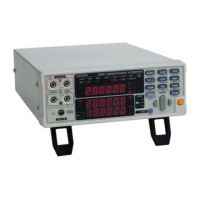Appendix 3 Temperature Conversion Function (
∆
t)
172
Utilizing the temperature-dependent nature of resistance, the
temperature conversion function converts resistance measurements
for display as temperatures. This method of temperature conversion is
described here.
According to IEC standard 60034, the resistance law may be applied
to determine temperature increase as follows:
Example With initial resistance R
1
of 200 mΩ at initial temperature t
1
of 20°C,
and final resistance R
2
of 210 mΩ at current ambient temperature t
a
of
25°C, the temperature increase value is calculated as follows:
Therefore, the current temperature t
R
of the resistive body can be
calculated as follows:
For a test object that is not copper or aluminum with a temperature
coefficient of
α
t0
, the constant k can be calculated using the formula
shown for the temperature correction function and the above formula,
as follows:
For example, the temperature coefficient of copper at 20°C is 3930
ppm, so the constant k in this case is as follows, which shows almost
the same value as the constant for copper 235 defined by the IEC
standard.
Appendix 3 Temperature Conversion
Function (∆t)
∆t Temperature increase [°C]
t
1
Winding temp. [°C, cool state] when measuring initial
resistance R
1
t
a
Ambient temp. [°C] at final measurement
R
1
Winding resistance [Ω] at temp. t
1
(cool state)
R
2
Winding resistance [Ω] at final measurement
k Reciprocal [°C] of temp. coefficient of conductor material at 0°C
∆t
R
2
R
1
------
kt
1
+()kt
a
+()–=
∆t
R
2
R
1
------
kt
1
+()kt
a
+()–=
210 10
3–
×
200 10
3–
×
--------------------------
235 20+()235 25+()–=
7.75°
C=
t
R
t
a
∆t+ 25 7.75 32.75°C=+==
k
1
α
t0
------- t
0
–=
k
1
3930 10
6–
×
----------------------------- 20 234.5=–=

